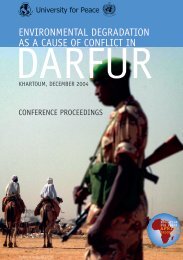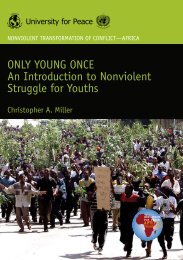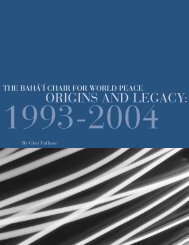who medicines strategy - libdoc.who.int - World Health Organization
who medicines strategy - libdoc.who.int - World Health Organization
who medicines strategy - libdoc.who.int - World Health Organization
You also want an ePaper? Increase the reach of your titles
YUMPU automatically turns print PDFs into web optimized ePapers that Google loves.
WHO MEDICINES STRATEGY 2004-2007 | 52EO 2.3Availability and affordability of TM/CAM enhanced through measuresdesigned to protect and preserveTM knowledge and nationalresources for their sustainable useRationaleWHO recognizes that TM knowledge is theproperty of the communities and nations wherethat knowledge originated and should be fullyrespected. However, in many parts of the world,knowledge of TM is often passed on orally fromone generation to the next, and can easily be lostor incorrectly transferred. The appropriate use ofTM requires the transfer of correct knowledgeand practice, in order to ensure its safety andefficacy. Preservation of knowledge of medicinalplants and medicinal plant resources — themost common form of medication in TM/CAMworldwide — is vital to ensure the safety andeffective application of herbal <strong>medicines</strong> in healthcare as well as their sustainable use.ProgressIn 2002, in response to increased awareness of<strong>int</strong>ellectual property rights issues relating to TM,WHO held an <strong>int</strong>er-regional workshop on this inBangkok, Thailand. The African Region has alsoorganized a meeting of regional experts to discussguidelines for the protection of TM knowledge.In 2003, WHO developed guidelines on GACP forcultivated and wild medicinal plants (see also EO2.2), which are designed, <strong>int</strong>er alia, to encourageand support the sustainable cultivation andcollection of medicinal plants of good quality.Many countries have started to take actionon protection of traditional medicine throughrecording the use of their traditionally usedmedicinal plants. For instance, in Côte d’Ivoire,the TM programme at the Ministry of <strong>Health</strong>carried out a survey involving traditional healthpractitioners in 7 of its 19 regions. As a result ofthis, a list has been drawn up of more than 1000plants used by traditional health practitionersin these regions and the TM programme hasdeveloped national monographs on 300 of thesemedicinal plants. National lists of medicinalplants have also been developed in Bhutan andMyanmar. Elsewhere, the Iranian Government











